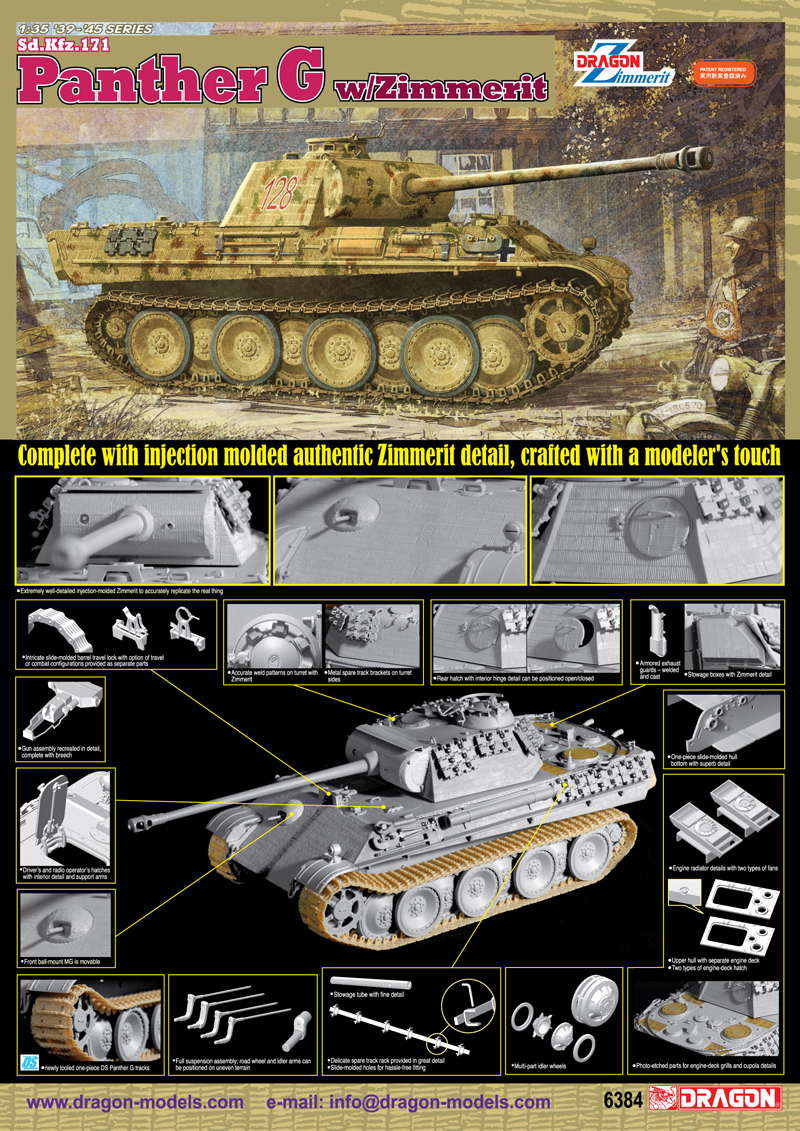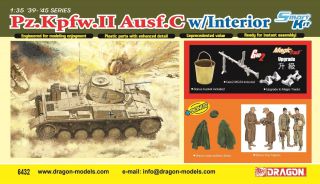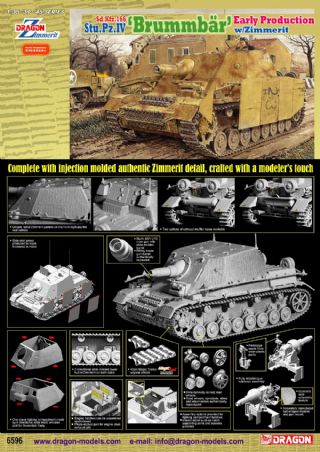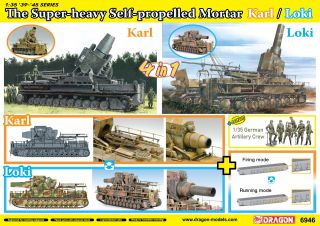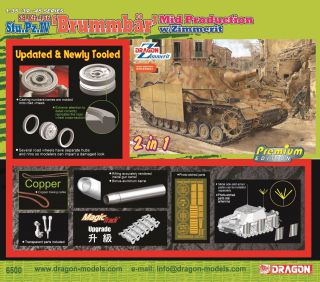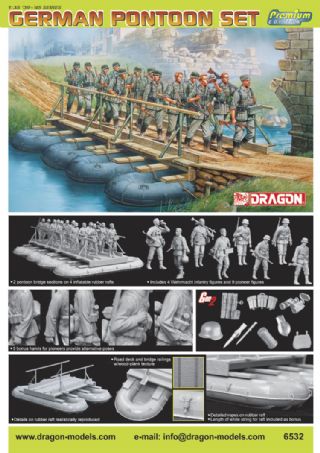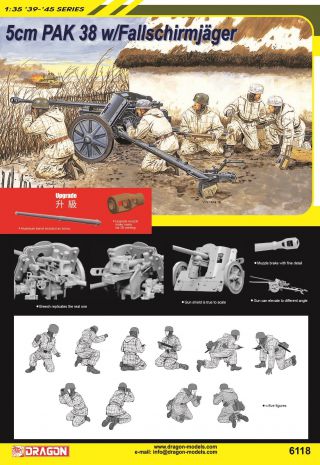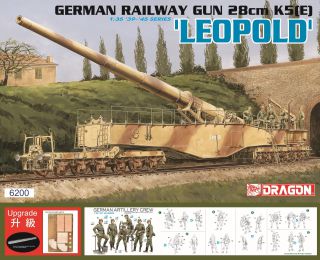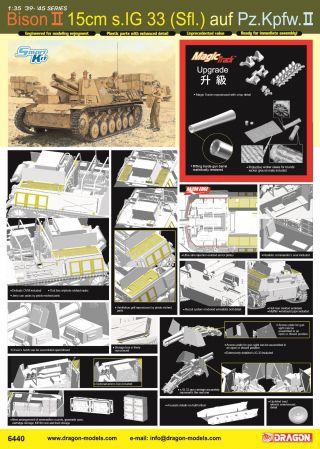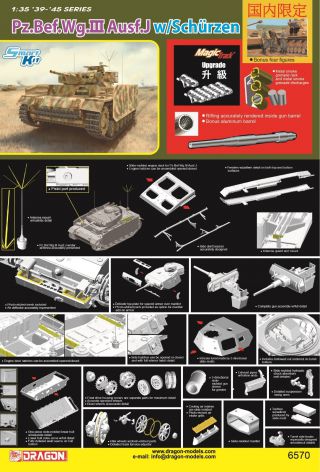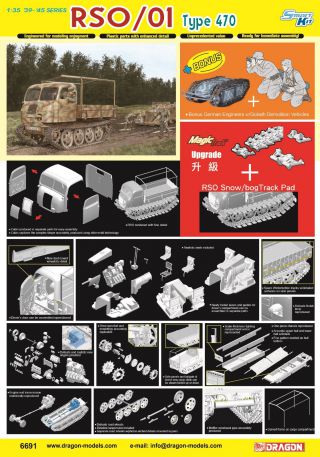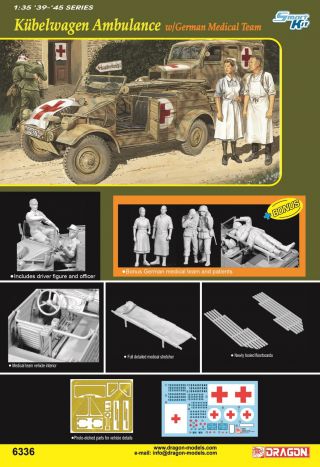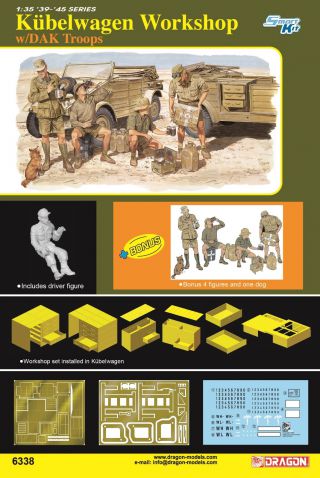HOME → Dragon Plastic Model Kits → 1/35 WWII Military → 6384
Barcode: 0 89195 86384 3
Case Pack: 20
Box Size: 9.6" x 15" x 3.1"
Carton Size: 0.167 cbm
Germany was stunned when highly effective T-34 tanks were first encountered on the Eastern Front, and its own Panzer III and IV tanks were simply outclassed. The Third Reich’s response was to design and produce the Pz.Kpfw.V, more commonly known as the Panther. Some regard the Panther as being the best tank of WWII, with an ideal balance of mobility, firepower and armor protection. Weighing 44.8 tonnes and operated by a crew of five, the Panther was armed with a long-barreled 7.5cm KwK 42 L/70 cannon. Various modifications were made to the Panther design throughout WWII, with the final and most numerous variant being the Ausf.G, of which 2953 were produced from March 1944 till the end of the war. New features on the Ausf.G included redesigned hull hatches, removal of the driver’s visor on the glacis, tapered one-piece upper hull side plates, and some later vehicles also had a new mantlet chin to eliminate the shot trap.
Dragon has launched a much-anticipated 1/35 scale kit of a Panther Ausf.G, with the unique aspect of this kit being the molded-on coating of zimmerit. Zimmerit was an antimagnetic paste applied to German armored vehicles between August 1943 and September 1944 to prevent enemy combatants from attaching magnetic mines. The zimmerit on this model is highly crafted with an authentic pattern and true-to-scale appearance. The inclusion of zimmerit required a completely new tooling of the turret, mantlet, upper hull and lower hull in order to replicate its characteristic pattern. The molded-on zimmerit means modelers are saved the ponderous and time-consuming chore of having to create this feature from scratch. Normally such a texture is only available in resin at a high cost…but zimmerit on this Panther comes at no extra charge! The rear stowage boxes made from DS are another exciting innovation on this kit, with these items showing realistic battle damage. This Panther offers modelers a vehicle that can immediately fit into a diorama, and it’s even more desirable after appearing in its completely new coat!
Reviews
Kit Review: Dragon Models Limited 1/35 Scale ‘39-‘45 Series Kit No.6384 ; Sd.Kfz. 171 Panther G w/Zimmerit; 590 parts (541 in grey styrene, 14 clear styrene, 12 preformed copper wire, 10 “Magic Link” tracks, 7 etched brass, 4 DS plastic, 2 twisted steel wires); retail price US $49.95
Advantages: “multimedia” kit results with a minimum of multimedia parts (19) in the kit; all major parts come with zimmerit in place; DS plastic tracks will be welcome
Disadvantages: no major items noted
Rating: Highly Recommended
Recommendation: for all German armor fans
Following their previous Tiger I and Tiger II kit releases with zimmerit, DML
has now released an early production Ausf. G with zimmerit parts as well. This
kit builds up as the early production model with the late Ausf. A mantlet and
the low fan housing on the engine deck among other details.
DML has replaced a total of 15 parts with new moldings (sprues M, N and P) that provide the G details with zimmerit in place. They have also thrown in two DS plastic rear stowage bins which have been, as the term used in the furniture business describes, “distressed” (as in somebody tried backing without a ground guide and found a tree by ear.) None of these parts appears to be related to the earlier Ausf. D with Zimmerit kit (No. 6428).
The rest of the kit is a nearly complete reissue of the first Ausf. G “Smart Kit” (No. 6268) with one major exception - it provides but ten “Magic Track” links for hanging as spares and instead comes with a newly tooled set of DS plastic tracks in tan from the Ausf. D kit. Each one is amazingly well detailed with hollow guide horns and other pertinent details, and are packed separately in a cardboard holder to prevent damage to the guide teeth. These tracks barely fit in the box due to their length, but they do fit and the review sample arrived in good shape.
As with the base kit, it makes heavy use of “slide molding” to get “multimedia” kit finish and part definition with a minimum of actual multimedia parts – here being only 7 etched brass parts, mostly the grilles for the engine deck, and two steel tow cables (large and small).
As before the lower hull is a one-piece “slide mold” part with all of the torsion bars complete and separate parts (the D had them as just the arm ends, not the entire bar.) Fine details such as “bump stops”, “pin knockers” and braces are all separate. The kit provides the rubber tired road wheels, but for a change of pace it also has two sets of “steel” road wheels for the last road wheel station on each side as an option. The model may be built with or without the small return roller wheel on the final drives, and both types are provided in the kit.
The hull rear plate comes with the late production “flame damper” exhaust pipes, which also have an optional two-piece hood for them (there are some things even DML hasn’t figured out in molding techniques yet, and going around corners is one of them – can’t change the laws of physics!)
On the hull top braces, locks and handles are provided for the “flip up” style of crew hatches. The engine deck is very complete, with radiators, radiator fans, screens, louvers and a large number of separate access ports and lids provided. All grilles replicate full castings and are separate parts as well. No engine or interior are provided with the kit, but the interior is set up for relatively easy installation so the after-market boys are going to be racing to see who gets their interior done first!
One glaring error in the directions is that DML tried to compensate for some of the complaints from earlier zimmerit-fitted kits with places to mount the fittings. But what they don’t tell you is that you have to drill out every one of the mounting holes from the inside of the hull and the other parts, even though their usual “stick me here” directions show them being used in the assembly steps. Check out the inside of the parts and drill BEFORE you start assembly!
The hull side trim is all plastic, but comes with "slide molded" mounts and access holes for pins or attachment in order to permit track links to be hung in a prototypical fashion on their racks. The same goes for the tools and OVM.
As noted the turret comes with only the early (rounded) mantlet with a one-piece plastic barrel and a three piece muzzle brake. The gun does have a minimal breech assembly but no other interior parts are provided except for the self-defense weapon (mine thrower) in the turret roof. The commander's cupola comes with clear vision blocks and two interior sections that fit inside the "slide molded" cupola to give it the right thickness.
The project was supervised by Hirohisa Takada with technical drawings by Minoru Igarashi. Technical assistance was provided by Steven Van Beveren, Tom Cockle and Gary Edmundson.
Four finishing options are provided – 12th SS Panzer Division "Hitlerjungend", Normandy 1944 (three color, red 128); 1./Pz.Rgt., 1st SS Panzer Division "Liebstandart Adolf Hitler", Paris 1944 (three color patches); 9th SS Panzer Division "Hohenstaufen", Normandy 1944 (three color patches, white 432); and Pz.Brig. 106, Northern France 1944 (three color, white 503). A small sheet of targeted Cartograf decals is provided.
Overall, given the popularity of Panthers and the "Smart Kit" line this should be a winner.
- Cookie Sewell
Product Specifications.
6384, Sd.Kfz.171 Panther G w/Zimmerit. 1/35th-scale styrene/multimedia kit containing 596 styrene parts (including 16 clear), four DS-100 soft styrene parts, one photo-etched brass fret, 12 metal parts, two lengths of braided metal wire, four decal/markings schemes and eight pages of instructions in 17 steps.
Introduction.
Based on the previously-released series of Panther Ausf.G Smart Kits, this new product will allow the modeler to construct an early Panther Ausf.G that was issued to the Panzertruppen with a factory-applied coating of Zimmerit anti-magnetic mine paste. This will allow the modeler to more easily construct a replica that served on the Ostfront from early 1944 as well as in the West, particularly at Normandy, in the summer of 1944.
Tracks.
This kit dispenses with the individual link Magic Tracks seen in most of DMLs Panther kits for complete lengths made of DS100 soft styrene. The tracks are of the later pattern with the small ice grips on the face of the links. The tracks come from a slide-mold, so the integral guide horns not only have proper rib details on their outer surfaces, but they have also been hollowed-out. In addition, track pin details are properly-rendered and the material can be fixed with standard styrene cement. This will ease assembly and also allow the modeler to easily depict track sag so typical of German dead-track links. There are also four smaller sprues that have a total of 16 hard styrene links with separate and properly detailed guide horns; a small number of Magic Track links are also provided for hanging about as spares. As a bonus, each small sprue for these track links contains five small and five very small wing-nuts (a total of 20 each); these little guys will come in handy, so make sure you consign them to the details bits box.
Suspension System.
The torsion bar swing-arm units are separate parts and depict the three different types that were used at various locations on this Panzer. Internal torsion bar details are also given, including the holders and various other bits. The idler wheel swing-arm is also separate, which will make fitting individual-link tracks much easier. Do not glue the idler wheel swing-arm into position until you are satisfied with the sag of the track. There are other separate detail parts for the suspension system that are fitted to the hull side plates, including bump-stops, track pin return plates and two pairs of cast final drive housings; one pair has the small return roller that mounted aft of the drive sprocket, while the other pair mounts the skid. For this version of the Ausf.G, use the type with the return roller only.
The drive sprockets feature the late-style hub-cap molded in place, while the
early-style idler wheels are in four parts including separate outer rims for
maximum realism. The standard rubber-tired road-wheels feature 32 rim-bolts
and have subtle rim detail where the tires are mounted.
Hull.
In order to accept the separate torsion bar swing-arms, the slide-molded hull pan has openings for them molded in place, as well as plate details, which correspond to the torsion-bars on the opposite side. Other bolt detail is included as well. At the front end there are separate plates that allow for complete detail on both sides of the final drive housings. The lower bow plate is separate and has a delicately-rendered Zimmerit pattern, while the belly plate is of the final type that came in two sections, with the front being 25mm-thick and the remainder being 16mm-thick. All drain plugs and access plates are provided and are in their proper locations and configurations. The sponson plates are separate parts and attach to inner sub-plates for a very positive fit; they are exquisitely detailed with weld beads, bolt patterns, recessed screw heads and an opening for the power conduit (also included) that ran to the fender-mounted Bosch head-lamp. Also provided are the lower mounting brackets that the Gepa"ckkasten (baggage bins) rested upon.
The hull rear plate has fine weld seam and access lid details, as well as the
prominent tow coupling that was mounted on the circular access plate. It is
also coated with Zimmerit. Early exhaust pipes are provided as are both welded
and cast armored guards for where the pipes entered the hull rear plate; this
option also includes the sheet metal heat shields that were wrapped around the
exposed pipes. Note that photos show Zimmerit on the armored guards, but DML
did not modify those parts. So, for complete accuracy, the modeler must add
Zimmerit to the type chosen for use. Not for use, but still included, are a
pair of marvelously-rendered slide-molded Flammvernichter (flame-dampening)
exhaust pipes, which are complimented by optional separate upper elbows. The
two Gepa"ckkasten (baggage bins) are slide-molded and have very-finely
detailed lids and clasps, as well as molded-on Zimmerit. Another pair of baggage
bins is provided in DS100 material; this has allowed them to be molded in a
dented condition, complete with chipped Zimmerit. Also, the bins are correctly-mounted
spaced away from the rear plate, with all the proper brackets. The final items
are a multi-part vehicle jack with delicate mounting brackets, convoy light
including clear part, and U-shaped tow clevises.
Superstructure.
The superstructure features integrally-molded front fender/mud flaps, which have separate detail parts as well as a single multi-part Bosch head-lamp (it is based on a slide-molded core with a separate clear styrene lens if the cap is left off) for the port side; there is a detailed mount under the fender with a separate power conduit, illustrating the dedication to fidelity of the kits designers. There are a couple of large, deep ejector pin marks under there as well, but they are hidden from normal view. The superstructure also has Zimmerit molded in the appropriate places on the side walls and the glacis plate. However, no location points are visible for the various tools and OVM brackets, etc. They are actually on the inside of the part and must be opened up by the modeler, as shown in steps 10 and 11 of the instructions.
The MG ball mount is new and also has Zimmerit added. It is provided with a
finely-detailed, slide-molded MG34 and mount; the machine-guns muzzle is pre-bored,
and there is a separate cap to be used if the MG is not in place. The separate
drivers and radio operators hatch lids (there are two styles provided) feature
separate grab handles (check photos; some Panthers had handles; some did not)
and complete underside detail. The springs seen on the inside of the transmission
access plate that attached to the lids are present as are external bump-stops.
Separate periscope armor guards for the driver and the RO are given as are clear
styrene periscope heads; the drivers scope also has a separate rotator plate
(remove the location tab and it can be movable) and sun-shade. The Heckzurrung
(external travel lock for tank gun) is separate and features an intricately
detailed chain segment due to the use of a slide mold. It can be configured
in use or laid down. The turret ring race has complete detail and does not have
cut-outs to keep the turret locked in place; personally, I prefer this method
as it will allow the modeler more latitude in display. Just be aware that although
the turret fits quite snugly, it may fall out if the model is inverted.
The engine deck has a number of options and also contains some internal bits.
It includes etched brass screens for the various air intake and exhaust grills.
Internally, there are the baffles and fan blades for the engine cooling system;
this includes the option of two different fan blade styles. Externally there
are two different styles of cast cooling air exhaust armor guards, with the
third option being the raised tower associated with the Kampfraumheizung (fighting
compartment heater); this should be consigned to the spares bin as it would
not normally be seen on a Zimmerit encrusted Panther Ausf.G, unless it was retro-fitted
to a survivor. The separate slat arrangements that were situated only on the
starboard side of the engine deck is given as either opened or closed options;
likewise the pie-slice plates that cover the raised tower can be mounted in
place or stored next to the opening. Two main engine deck plates are given;
the differences are extremely subtle and quite difficult to distinguish, consisting
of the same number of openings around the rim, but with differing styles of
fasteners within them. A separate engine deck access hatch lid is given as are
various fittings, hooks and filler caps. An antenna base is provided, but there
is no rod antenna included.
The superstructure side plates feature proper weld bead and interlock details
and have separate mounting frames for the tools and spare tracks. In styrene,
the latter are very cleverly slide-molded and include properly-rendered U-shaped
track hangers complete with small holes for the separate (and finely-molded)
L-shaped holding pins. The tools have molded-on clasps; these are very accurately
depicted and with proper cleaning will look the part very convincingly. A jack
block with wood grain texture sits in its tray and two styles of large tow cable
loops are provided; they come from a slide-mold and are pre-bored to accept
the provided wound metal wire tow cable. Separate U-shaped hooks with separate
L-shaped pins hold the cables in place on the engine deck. The thinner track
changing cable is also provided along with proper end-loops
No Schu"rzen plates are provided. The rails on either side of the superstructure
side plates are there, as are the hooks (in styrene). For the sake of versatility,
it might have been good to have them; regardless, the Cyberhobby upgrade for
the Ausf.G Smart Kit has them and Eduard has an etched brass Schu"rzen
set for the same kit. So, if the modeler feels the need, they can be had. And,
they would not be too difficult to make up from styrene sheet, using the cited
references as a guide.
Turret.
This is topped by a superbly-designed cast Prismenspiegelkuppel (commanders cupola with periscopes); its exterior is from a slide-mold, so that the area beneath the armor guards for the periscope heads is properly rendered. Clear styrene scope heads are then inserted from the inside, which has the proper thickness due to separate ring inserts. The multi-part hatch lid is completely detailed inside and out. There is a Fu"hrungsring fu"r MG (ring for machine gun) and Fliegerbeschu?gera"t (anti-aircraft mount for an MG34), but no MG34 is provided. Finally, there is a separate external commanders blade sight.
Zimmerit has been molded onto the side and rear walls, while a new multi-part
gun mantlet is covered by a new outer shield, all of which have Zimmerit. This
unit is topped by the sheet metal debris guard. The 7.5cm KwK42 L/70 gun tube
is a conventionally-molded one-piece all-styrene item, capped by a three-part
slide-molded styrene muzzle brake. The gun tube matches drawings in Panzer Tracts
5-3 very precisely and includes the subtle change in taper seen towards the
rear; internally, there is basic breech detail for it. The turrets rear plate,
as well as its attendant escape hatch has also been revised with Zimmerit coating;
the hatch lid is movable and also includes fine hold-open latch detail.
The turret roof has separate grab handles, lifting hooks, two different fan
vent cover plates (forged and welded), separate armored splash guard for the
vent, molded-on Pilsen (crane mounts) with excellent weld and drain details,
separate clear styrene loaders periscope (with armored guard), and a slide-molded
Nahverteidigungswaffe (close defense weapon); this can be configured with an
opened or closed port and includes the internal part of the weapon. Separate
shaped metal wire parts are provided to hang spare track links upon. No location
marks are on the turret, nor are dimensional notes provided in the instructions;
these will have to be eye-balled in place by the modeler, which should not be
too much of a chore if one uses a track link as a spacer.
Molding, Fit and Engineering.
Overall, I found one fit issue. The Gepa"ckkasten (baggage bins) must rest on top of the brackets (G10 and G11) but will not because of the placement of the location holes on their inner faces. The solution is easy: simply remove the pins on the hull rear plate and align everything by eye. No sink marks were found, and in every case except for the above-mentioned individual link tracks, there were no visible ejector pin marks.
Accuracy.
The recent four-volume series from the Panzer Tracts team, backed up by their classic work for Schiffer (see listing below) was the base reference for this scale models physical attributes. After removing many of the major components from the sprues, I began laying them on the various sets of drawings in the Panzer Tracts book (No.5-3). Without exception, the fit was superb. Given that these drawings are widely held to be the ultimate reference for this Panzer, I can probably safely conclude that the overall accuracy level of this kit is quite high. It has been said that the turret rear plate has the escape hatch opening in the wrong place. Using drawings in the cited references, I could not find this discrepancy; the kits part matched the drawing very well.
Any issues I have with this kit are solely related to the few omissions that
are noted, such as:
No Schu"rzen plates.
No anti-aircraft MG.
No radio antenna mast.
No Zimmerit on the armored guards for the exhaust pipes.
Instructions.
The instructions are presented in the conventional manner, with intricately-detailed line drawings. Almost all of the main steps contain one or more sub-steps separated into small boxes; this will assist the modeler in preparing subassemblies for placement when needed.
Decals and Markings Information.
The decals are from DMLs usual supplier, Cartograf of Italy. All items are in perfect register, feature crisp edges and fine color saturation. Carrier film is thin, matte and closely cropped to the edges of the designs. The following four Panthers can be modeled:
12.SS-Panzer-Division Hitlerjugend, Normandy 1944.
1.SS-Panzer-Division Liebstandarte Adolf Hitler, Paris 1944.
9.SS-Panzer-Division Hohenstauffen, Normandy 1944.
Panzer-Brigade 106, France 1944.
Conclusion.
Fans of the Panther and those who have an interest in modeling AFVs seen during the campaigns in early/mid 1944 will find this kit most welcome. It is very accurate, has several useful options and most of all obviates the necessity for those who want a correctly-attired Panther to apply their own Zimmerit.
Highly recommended.
- Frank V. De Sisto

